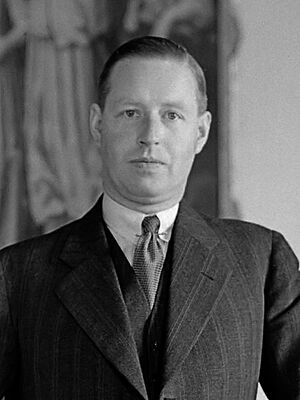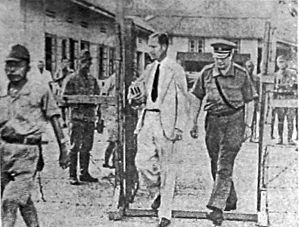Alidius Tjarda van Starkenborgh Stachouwer facts for kids
Quick facts for kids
Alidius Tjarda van Starkenborgh Stachouwer
|
|
|---|---|

Tjarda van Starkenborgh Stachouwer in 1935
|
|
| Governor-General of the Dutch East Indies | |
| In office 16 September 1936 – 8 March 1942 |
|
| Preceded by | Bonifacius Cornelis de Jonge |
| Succeeded by | Hubertus van Mook (in exile) |
| Queen's Commissioner in Groningen | |
| In office 1925–1933 |
|
| Monarch | Wilhelmina of the Netherlands |
| Preceded by | Edzard Tjarda van Starkenborgh Stachouwer |
| Succeeded by | Joachimus Pieter Fockema Andreae |
| Personal details | |
| Born | 7 March 1888 Groningen, Netherlands |
| Died | 16 August 1978 (aged 90) Wassenaar, Netherlands |
Jonkheer Alidius Warmoldus Lambertus Tjarda van Starkenborgh Stachouwer (born March 7, 1888 – died August 16, 1978) was a Dutch nobleman and an important leader. He is best known for being the last Governor-General of the Dutch East Indies, which is now Indonesia.
He was in charge when Japan took over the islands during World War II. He was captured after agreeing to Japan's demands on March 9, 1942. Tjarda was the 69th governor-general of this large Dutch colony in Asia. He served from 1936 to 1942.
He came from an old noble family in Groningen, Netherlands. His father, Edzard Tjarda van Starkenborgh-Stachouwer, was a professor and later a mayor. His mother, Christine Jacobe Quintus, was a music teacher and opera singer.
Early Life and Career Beginnings
Tjarda went to school in Groningen. He then studied law at the University of Groningen from 1906 to 1911. After his studies, he worked at law firms. He also helped the Dutch Minister of Foreign Affairs.
From 1913 to 1915, he worked for the Dutch Foreign Office. His first job overseas was in Washington, D.C., at the Royal Netherlands Embassy. There, he met Christine Marburg, whose father was the US ambassador to Belgium. They got married in November 1915.
In 1921, Tjarda helped the Dutch team at the Washington Naval Conference. This was his first time dealing with colonial matters. He later worked on international trade in The Hague. He also helped organize local services in Groningen, like school doctors and the university.
From 1925 to 1933, he became the Queen's Commissioner (a royal governor) for the Province of Groningen. He took over this role from his father. After that, he was the Ambassador to Brussels (Belgium) from 1933 to 1936.
On June 4, 1936, he was chosen to be the Governor-General of the Dutch East Indies. He traveled there and officially took office on September 16, 1936, in Batavia.
World War II and Captivity
When the Netherlands surrendered to Nazi Germany in May 1940, Tjarda declared a state of emergency in the Dutch East Indies. He ordered that German ships be taken and German citizens be held. This was done until the Netherlands could be freed.
In December 1941, Japan began its attacks in the Pacific. The Dutch East Indies had about 93,000 Dutch troops. They also had 5,000 American, British, and Australian soldiers to defend against an invasion.
By February 1942, Japanese planes were bombing Batavia (now Jakarta). The government had to move its operations to Bandoeng. Tjarda and other officials stayed in a villa there. He saw that the Allied troops and local people could not defend themselves. They lacked ammunition and were sick.
He decided to negotiate a surrender. On March 8, 1942, Tjarda met with Lieutenant General Hitoshi Imamura of the Japanese Army. They set a deadline for the unconditional surrender of the Dutch East Indies. The next day, Tjarda ordered Dutch and Allied troops to stop fighting. The Allied forces surrendered at 1:00 p.m.
Tjarda van Starkenborgh, his family, and other Dutch officials were taken prisoner. The Japanese offered him special treatment, but he refused. He wanted to stay with his people. He was separated from his wife, Christine, and his two daughters. They were held in a different camp.
Tjarda was first held in Bandoeng, then Batavia. Finally, he was moved to Manchuria, in a place called Hsien (now Liaoyuan, China). He was held there with other important prisoners, like US General Jonathan Mayhew Wainwright IV. The camp was freed by Soviet forces on August 16, 1945.
Life After the War
After the war, Tjarda van Starkenborgh returned to the Netherlands with his family. Queen Wilhelmina asked him to return as governor-general. However, he refused. He did not want to be involved with Indonesia's process of becoming independent. He resigned as governor-general in October 1945.
In 1946, he became the ambassador to France in Paris. After two years, he asked to leave this role. In 1950, he returned to public service. He became the Netherlands' representative to the North Atlantic Council in London. From 1952 to 1956, he led the first Dutch team to NATO in Paris. He helped prepare for a European Political Community.
On June 28, 1956, he was given the special title of Minister of State. He then retired from diplomatic work. He settled in Wassenaar and continued to lead the Carnegie Foundation. He also helped with talks about canal connections with Belgium. These talks led to a successful treaty in 1963.
Tjarda van Starkenborgh passed away in the Netherlands on August 16, 1978. He was buried in Wassenaar.
Honors
 Grand Cross of the Order of Orange-Nassau
Grand Cross of the Order of Orange-Nassau Knight Grand Cross of the Order of the Netherlands Lion
Knight Grand Cross of the Order of the Netherlands Lion Resistance Star of East Asia 1942–1945 (awarded May 10, 1950)
Resistance Star of East Asia 1942–1945 (awarded May 10, 1950)- Honorary Doctor of Philology and Philosophy from the University of Groningen (awarded March 20, 1957)
- Honorary Doctor of Literature and Philosophy from the University of Paris




